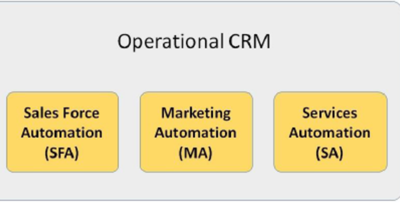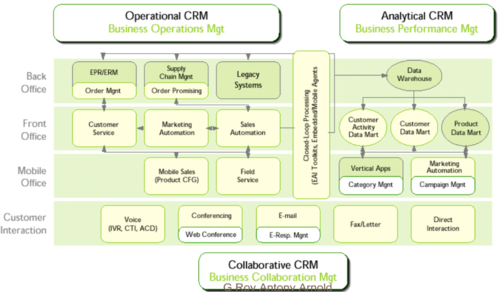Operational CRM
Operational CRM is a subset of CRM focusing on the direct interactions of the customer with the company, with a view to keeping the customer satisfied and happy, thus helping the company grow. There are two main methods by which a customer can have direct interactions with the company:
- Face-to-face personal interactions: Examples of personal interactions would be when the customer interacts with people from the call centers, or customer service representatives.
- Interactions with any websites or call centers (or other means of communication between the customer and the company): Examples of systems interactions would be when the customer interacts with automated software systems for sales, possessing orders, and monitoring inventory - also called sales force automation.[1]
Operational CRM generally refers to services that allow an organization to take care of their customers. It provides support for various business processes, which can include sales, marketing and service. Contact and call centers, data aggregation systems and web sites are a few examples of operational CRM. If your company has a high customer turnover, or perhaps high service costs, Operational CRM tool may be the solution to have access to information about your customer as well as giving you a clear view of your customers needs.[2]
Operational CRM is mainly focused on automation, improvement and enhancement of business processes which are based on customer-facing or customer supporting. The main importance of a CRM system lies on how the selling, marketing and service oriented processes are automated, and for which operational CRM systems are embedded with following major automation applications:
- Marketing automation- As the name implies, marketing automation is basically focused on automating marketing processes. In marketing, campaign management involves marketers to use customer specific information to determine, evaluate and develop communications that are targeted to customers in individual as well as multilevel or multichannel environment. Campaigns developed to communicate customers individually are easy and involves unique and direct communications. For multichannel environment the implementation of marketing strategies and campaign management is quite difficult and challenging. For example, some retailers have multichannel transactions like shops or stores, wholesale stores, websites, home shopping and even television shopping. Here integration and implementation of communication strategy is difficult and evaluation of performance and quality of campaigns needs to be automated and should be technologically sound across each of the channels. For handling this, a CRM marketing strategy called event-based marketing is inherited. Using event based marketing communication and offers are presented to customers as and when they are required. For example, credit card customer calls the call center for inquiring the current interest rates, this indicates that customer is specific about the interest rates and is trying to compare the interest rates and may switch to different competitor to find specific deals which suits him. Without wasting time the automated CRM system pops up an event of offer which is best suited for that customer and helps to retain him back.
- Sales-force Automation- A CRM system is not only used to deal with the existing customers but is also useful in acquiring new customers. The process first starts with identifying a customer and maintaining all the corresponding details into the CRM system. This process can be distributed into many stages which includes generation of lead and then qualifying those leads as prospects. The Sales and Field representatives then try getting business out of these customers by sophistically following up with them and converting them into a winning deal. Automation of selling process is efficiently handled by Sales-force automation which automates all the methodologies or sales cycle and above described process sophisticatedly.
- Service Automation- Service automation deals with managing organization’s service. The actual interactions with customers such as contact, direct sales, direct mail, call centers, data aggregation systems, web sites and blogs etc. are examples of operational CRM. Each interaction with a customer can be collected to the client database generally known as ‘customer’s history’ and the information can later be used wherever necessary. Any one in the organization can have access to this information about customer which gives a clear view of customers needs and important information on the customer such as products owned, prior support calls etc. It naturally eliminates the need to obtain this information individually from the customer. On the basis of the information, if required, the customer can easily be contacted at right time at the right place.[3]

source: Tutorials Point
Operational CRM - What Works What Doesn't Work

source: Collier Pickard
Comparing Operational and Analytical CRM
The tools and other resources used in operational CRM and Analytical CRM are often essentially the same. The resources themselves are considered part of the business operations, or operational CRM. The analysis of the data collected through these operations is analytical CRM. Effective operational CRM contributes to solid analytical CRM, which leads to more targeted marketing and better customer experiences.[4]
This model below shows how operational and analytical CRM fit together. It is a complete overview of all processes.

source: G Roy Anthony Arnold
See Also
References
Further Reading
- Operational Customer Relationship Management (CRM) Zaheer Abbas
- What is Operational CRM TechOneStop
- Operational CRM - Extensive Overview Michael Taylor
- Operational CRM eBook Collier Pickard
